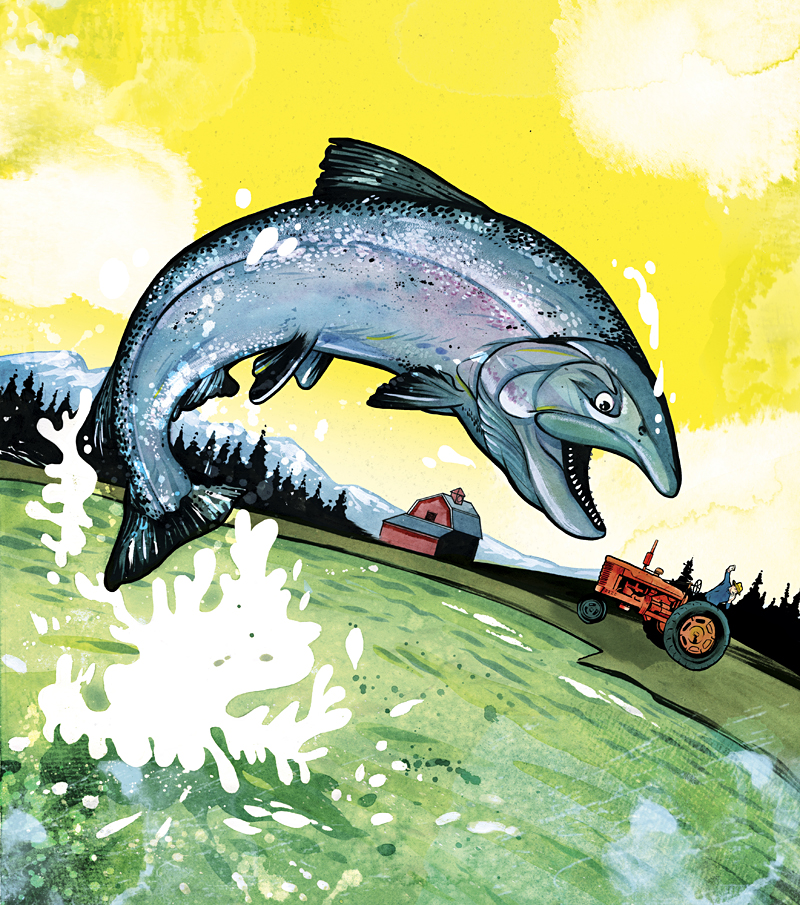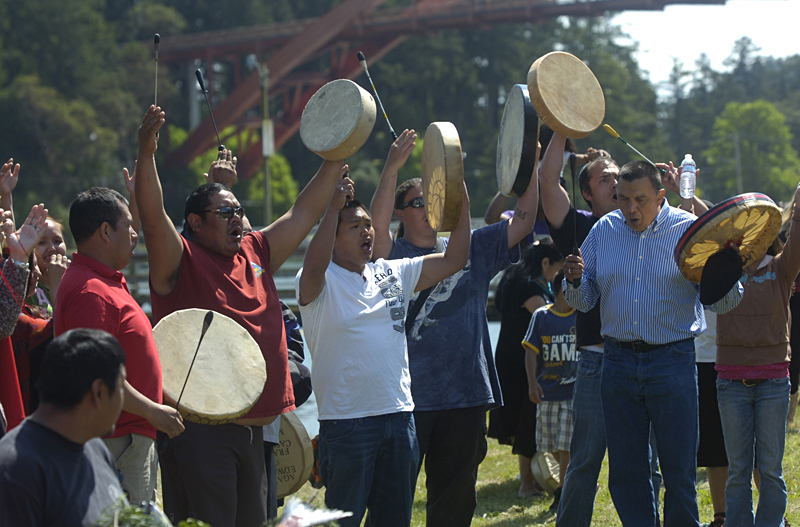Here is Dave Hedlin’s recipe for the side-by-side survival of Skagit Valley farmers and Native American fisheries: “Salmon fettuccine,” he says, a smile wreathing his broad face, pink-tinged from summer days spent in his vegetable fields near La Conner.
“You take Skagit salmon, mix it with pasta made from Skagit soft winter wheat, add organic butter and cheese from Alan Mesman’s dairy and vegetables grown here in the valley, and you have a perfect dish—all produced within three miles of here.” The idea reflects Hedlin’s hope that the families who farm the lush Skagit River delta can work with their Swinomish tribal neighbors to see that agriculture and salmon can not only survive but thrive in the same space.
But lately, the ingredients have not been mixing well. Here in this delta, where the fresh waters of the Skagit mingle with the Salish Sea, is the skirmish line for a water-rights battle 158 years in the making. While parties on both sides say they want a fair resolution to the fish-versus-farms dilemma, that may not come without bumps and bruises along the way.
The Skagit delta farming system’s intricate rotation of some 80 vegetable and seed crops has been 150 years in the making. Dikes to keep the low-lying farmland dry and tide gates to prevent saltwater incursion into croplands are valuable to farmers, but not so much to Natives trying to revive salmon runs on the third largest American river on the contiguous West Coast.
The Swinomish Tribe’s priority is fish, not farms. And a century and a half of treaty law has put in their hands considerable power to press their case. In 1855, territorial Governor Isaac Stevens negotiated with western Washington tribes, trying to coax them into giving up millions of acres of land and retreat to reservations with prescribed boundaries. The Treaty of Point Elliott, signed by tribal leaders at a place later known as Mukilteo, included a guarantee of perpetual fishing rights. The treaty included this language: “The right of taking fish, at all usual and accustomed grounds and stations, is further secured to said Indians in common with all other citizens of the Territory, and of erecting temporary houses for the purpose of curing them, together with the privileges of hunting, gathering roots and berries, and pasturing their horses on open and unclaimed lands.”
The precise meaning of that passage would not be settled for another 119 years. But the tribes never doubted what it meant to them. Over the next century, congressional efforts were made to eliminate reservations and assimilate Natives into mainstream society. Many reservations were broken into privately owned parcels, with some of the land acquired by non-Natives.
By the mid-20th century, salmon stocks began to fade, due in large measure to overfishing and habitat destruction. After a 1953 act of Congress gave states extensive jurisdiction over tribes in criminal and civil matters, Washington state officials interpreted the law to mean that Natives were bound by the same state fish and game regulations as non-Natives. Commercial fishing fleets, with their superior technology, played a major role in depleting salmon runs. Natives could not compete—by some estimates, they pulled in little more than 5 percent of the total catch. Native “fish-ins” in defiance of state authority were dealt with severely by law enforcement, even on reservations.
A violent confrontation over treaty fishing rights between Natives and state and local law enforcement on Sept. 9, 1970, was the catalyst for the federal court case that changed everything for Washington’s tribes. “They gassed us Indians and threw us in jail,” writes Billy Frank Jr. in his newspaper op-ed column, “Being Frank.” Frank is a Nisqually tribal leader who was there that day on the banks of the Puyallup River in Tacoma. Frank, now 80, with a craggy face and white hair to his shoulders, has told the tale many times. “But someone else got gassed that day, too,” he adds. “His name was Stan Pitkin, the U.S. Attorney for western Washington.”
An appointee of the Nixon administration, Pitkin had established a reputation for integrity and fair-mindedness. He watched on Sept. 9 as state troopers, sheriff’s deputies, and Tacoma Police SWAT Teams descended on a Native encampment under the Highway 99 bridge over the Puyallup River. Bullets were fired, though nobody was reported hit. But officers’ billy clubs flailed, tear gas filled the air, and about 60 people were arrested.
Disturbed by what he had seen, Pitkin filed a federal lawsuit nine days later charging the state of Washington with violating Native treaty fishing rights. U.S. District Court Judge George Boldt presided over the case for more than three years before issuing a decision that would come to be known as the most important in the history of Native law.
On Feb. 12, 1974, all the parties to the lawsuit gathered in Judge Boldt’s courtroom in Tacoma. His words shook the room: “By dictionary definition and as intended as used in the Indian treaties and this decision, ‘in common with’ means sharing equally the opportunity to take fish at the ‘usual and accustomed grounds and stations’; therefore, non-treaty fishermen shall have the opportunity to take up to 50 percent of the harvestable number of fish that may be taken by all fishermen at usual and accustomed grounds and stations, and treaty-right fishermen shall have the opportunity to take up to the same percentage of harvestable fish.”
The tribes now laid claim to a court-ordered 50 percent of the western Washington salmon catch. The non-Native commercial fishing industry virtually collapsed overnight. A federally financed program was launched to buy the boats of fishermen left without a livelihood, and the 28 treaty tribes of western Washington were now to be the co-managers of what was left of one of the world’s greatest fisheries.
The consequences of Boldt’s decision have been felt far from the reservations that are home to the western Washington tribes whose representatives put their “X” marks on the Treaty of Point Elliott. One of the signing chiefs was a Swinomish chief known as Kel-kahl-tsoot, great-great grandfather of the tribe’s current chairman, Brian Cladoosby.
Boldt, otherwise little known, had carved himself a special place in federal jurisprudence. He was also burned in effigy by white fishermen. The Boldt decision not only revived Native fisheries, it also assured the tribes that they not only had the right to co-manage the salmon fishery, but also to exercise their tribal sovereignty as they saw fit.
The next crucial measure was supplied by Congress, which passed the Indian Regulatory Gaming Act in 1988. The law empowered states to negotiate compacts with tribes allowing them to engage in any kind of gaming activity that was allowed anywhere in the state where the tribe is located. In Washington, an innovative version of the state-sponsored lottery created video games that mimicked slot machines.
When non-Native gambling interests in Washington state sought in 2004 to break the tribal monopoly on video machines—the most profitable of gaming devices—the tribes responded with an awesome display of financial clout to defeat Initiative 829. In all, backers of the initiative were outspent by the tribes $6.6 million to $1.06 million. The Tulalip Tribe alone contributed $1 million to the effort, while the Swinomish weighed in with $250,000. Gov. Chris Gregoire, who has negotiated several of the tribal gaming compacts, benefited in her 2008 re-election campaign from about $650,000 in tribal contributions.
Empowered by both political and legal muscle, the tribes are driving state and federal agencies to live up to their obligations to preserve salmon with an ever-present threat of lawsuits that’s keeping agency bureaucrats on edge. And Skagit farming could find itself collateral damage as the Swinomish draw a hard line in their quest to revive Skagit River salmon runs.
Nicholas Zaferatos worked for the Swinomish from 1984 to 1999, and is now on the faculty of Western Washington University’s Huxley College of the Environment. In his 2001 WWU doctoral dissertation, he offered this theory: “By declaring a policy that asserted its own political authority in most matters concerning reservation development, the Tribe effectively disrupted the political status quo. No longer would non-tribal jurisdictions presume to have unchallenged authority over activities that affected the reservation.”
In other words, the tribe would reach out in any direction where it saw its interests being impacted. It would challenge off- reservation authority when it felt its sovereignty threatened, and negotiate settlements where it could. As a result, the Skagit River delta farming community has been dealing with Swinomish demands for a say concerning tide-gate improvements and what the tribe claims are unpermitted extractions of water from drainage ditches for irrigation purposes. The delta is made viable for farming by an intricate system of dikes and tide gates that keep the low-lying land dry and free of saltwater incursion from Puget Sound.
Dave Hedlin’s grandfather was among the pioneering delta farmers who built the system of dikes that exists today, often with little more than pick and shovel. Agriculturalists rhapsodize about the quality of delta soil, built from millennia of volcanic ash, glacial silt, and clay loam. The Skagit Valley produces 80 varieties of crops, some—such as red potatoes and Yukon golds, raspberries, blueberries, and strawberries—accounting for significant export income to farmers. The valley also grows more cabbage, broccoli, and spinach seed than anyplace else in the United States.
The valley cropping system is an intricate choreography of rotations needed to assure that the land is not exhausted and that seed crops are protected from pollen drift. The complexity of Skagit delta farming is the prime argument farmers use for maintaining a “critical mass” of acreage to make the system work. Today, the best estimate of experts from the Western Washington Agricultural Association is that the valley’s current 70,000 acres of farmland is right at the tipping point; Skagitonians to Preserve Farmland applied for a $300,000 grant from the U.S. Environmental Protection Agency to study fish-habitat needs in the delta and what minimum acreage is needed to sustain local agriculture.
“It’s just another piece of information in an incredibly complex series of questions,” says Hedlin.
The Swinomish are pressing for a tide-gate system that won’t block fish and for a return of up to 2,700 acres of delta lands to estuarine habitat for fish, and experimental projects have been launched that are aimed at responding to those goals. Farmers say they are willing to go along, but not without some assurance from the tribe that agriculture won’t be expected to give up still more land later. So far, the tribe has been unwilling to offer that assurance.
On one level, it has the flavor of a family fight. The tribal and farming families have formed close relationships over the years. Swinomish Chairman Cladoosby has acknowledged that tribe and town have much to share. Cladoosby, in an interview with the Skagit Valley Herald last year, remembered fondly stories elders told him of the generosity of Dave Hedlin’s mother, Elizabeth, who saw to it that starving tribal members had food to eat during the Great Depression.
But that was then: In recent years, Cladoosby has emerged as not only a leader and dominant political force in Northwest Indian politics and a fervent advocate of tribal sovereignty, but a national figure as well. To wit, last year he was chosen to be one of 12 national tribal leaders to meet with President Obama to discuss Native American issues. He is often showered with praise by other tribal leaders for his devotion to advancing tribal sovereignty and his “spirituality”—as a Seventh-Day Adventist, Cladoosby frequently invokes “The Creator” in his speeches and writings. He appears at times a holy man invoking ancestral spirits, at others a practical politician with higher ambitions.
Cladoosby was honored last year at the annual meeting of the Affiliated Tribes of Northwest Indians, as he stepped down after a two-year term as the group’s president. “My elders saw in me something that I didn’t see,” Cladoosby told tribal delegates on the first day of the annual meeting. “God saw something in me that I didn’t see. As chairman at Swinomish, I have the greatest job in the world.”
Cladoosby’s idea of himself as a God-ordained man on a mission only adds to the frustration of non-Natives who must contend with the Swinomish tribe’s demands on water rights, land use, and fish protections. (Cladoosby has declined repeated requests over several weeks for interviews.) Will Honea, chief civil deputy prosecutor for Skagit County, has battled in court with Swinomish tribal attorneys on water issues, and questions what the tribe has gained through litigation.
“The Swinomish approach is about constant conflict and zero compromise, which is a failure by all measures other than elevating Chairman Cladoosby’s perceived political power,” says Honea. “This approach has accomplished almost nothing for salmon despite tens of millions spent on litigation, and has soured farmers and rural landowners on the idea of environmental protection.”
Today, the Swinomish and other tribes signatory to the 1855 Treaty of Point Elliott have consolidated their reaffirmed fishing rights and casino dollars into a new, muscular form of sovereignty. And they are asserting themselves in every way possible.
In some of the state’s most important salmon-producing watersheds, Native water-rights claims are being weighed against competing uses in urban and agricultural communities. Nowhere is that issue more contentious than in the Skagit Valley, Puget Sound’s largest river basin and home to five species of salmonids, three of which are designated threatened under the Endangered Species Act.
The Swinomish say they are determined to bring back several of the great Skagit River salmon runs of yore. The tribe’s determined pursuit of that goal has it pushing for something akin to not just co-management of the fish, but of the water they swim in.
The Swinomish and two other tribes based in the Skagit River watershed sat down with state, county, and local water-district officials to hammer out a landmark water-rights agreement in 1996. It led to the setting of rules by the state Department of Ecology regarding minimum flows in the Skagit River and key salmon-spawning tributaries for the protection of salmon. The purpose of the agreement, as stated by all participants, was to avoid litigation over the tribes’ senior water rights for 50 years. The Skagit County Public Utility District and the city of Anacortes were guaranteed water to be set aside for future growth needs.
But somehow, the issue of water rights for rural well-users was not addressed. The Department of Ecology amended the rule in 2006 to provide for rural wells that were not able to receive piped water. As a result, the Swinomish filed suit against the DOE to throw out the amended rule.
Meanwhile, the Swinomish have kept up the pressure on the DOE to close some creek basins to further water draws to protect spawning beds. Last June, the agency notified Skagit and Snohomish counties that the Carpenter and Fisher Creek sub-basins were closed to further residential wells. That left Zachary Barborinas feeling high and dry after spending $155,000 for a one-acre lot with a well that he now can’t use.
“Here it is,” he says with a sweep of his arm toward the weed-covered lot in a subdivision of mini-mansions, some surrounded by well-watered and clipped lawns. The property in the low-lying hills just south of the Skagit County line offers a distant view of Puget Sound.
A gentle breeze brushes downslope from the Cascade Mountains to the east, and the air is fresh and clean. Barborinas, a 34-year-old pilot for private clients, bought the property in 2009. Utilities were in place, and a 400-foot-deep well capable of pumping 35 gallons a minute would provide more than enough water. He planned to build in the near future.
Barborinas and his wife Adele signed the papers for the property on Dec. 15, 2009. They had no idea that just four days earlier the state Department of Ecology had issued a warning that their water supply was in jeopardy. “There was no warning from Snohomish County Planning or [the] Snohomish County Health District prior to or after closing,” Barborinas says. “Furthermore, I had just completed a septic redesign with the Health District to purchase the property—a requirement to ensure it would meet our needs.”
Scores of other property owners were in similar circumstances. Angry meetings ensued. While it was DOE data that had determined the creek basins were tapped out, it was the Swinomish tribe that had forced the agency’s hand by threatening a lawsuit. For the tribe, the Carpenter-Fisher closure was a line in the sand.
Some blamed the tribe for the action by the DOE. But the decades-long paper trail leading to the ban on wells suggests that there was ample reason for the DOE to have addressed the issue much sooner. On Dec. 16, 1992, an official of the state Department of Fisheries wrote to the DOE urging that the Carpenter Creek watershed be considered for closure to further water rights. The letter, by Kurt Buchanan, then regional habitat manager, noted that the creek was then considered “a very generous system in the production of salmonid fishes.” He wrote, “Further appropriation of water from this watershed should not occur if it will affect the already low flows during summer and early fall.”
The 7,000-acre Swinomish reservation is a mix of private ownerships by both Natives and non-Natives, leaseholds, and a small patch of land owned by the tribal community as a whole. The 250-acre patch, known as Swinomish Village, is also the seat of government for the tribe.
This checkerboard pattern of land ownership on the Swinomish reservation (and, actually, on most reservations in the country) is the legacy of the 1887 General Allotment Act, wherein land remaining after tribal members received their parcels was distributed to white settlers.
Where Bob Eberle lives, Natives make the rules—to his annoyance, without his say-so. The sprawling $470,000 rambler he shares with his wife Claire sits in the middle of the Swinomish Indian reservation. The 77-year-old conservative Republican activist would put an end to the sovereignty of America’s treaty tribes if he could. “I think the whole concept of Indian sovereignty is erroneous,” says Eberle, who objects to coughing up Swinomish tribal taxes and paying for building permits for which he also pays Skagit County.
Neither the state nor federal government has an ear for his complaint. Still, he tries. Eberle and his wife, also a state Republican committeewoman, caused a stir in Native country when they went to June’s state party convention in Tacoma armed with a proposed plank for the party platform that called for the federal government to require tribes to allow non-Native residents on reservations a say in tribal government. Their fellow Republicans let the language die on the platform-committee floor. Should the Eberles’ efforts one day prove successful, however, an everybody-votes requirement would likely end the Swinomish tribe’s control over its own reservation, as about 70 percent of the reservation’s approximately 3,000 residents are white.
It was a blustery May afternoon on the Swinomish reservation, ideal for the annual Blessing of the Fleet. The sky was mostly cloudless and powder-blue. A procession of about 300 people led by drumming, chanting tribesmen marched from the reservation gymnasium to the site of the ceremony on the west bank of Swinomish Channel.
The opening of a tribal fishing season is as much a spiritual event as a celebratory gathering. Prayers were led in succession by ministers of the Catholic, Methodist, and Native Shaker churches. The haunting chants of a female Shaker “prayer warrior” rose and fell over the crowd. Tribal elder Jimmy Wilbur held aloft an eagle carving containing cedar bows and turned north, west, east, and south to offer a blessing to the four cardinal directions.
Chairman Cladoosby underscored the ceremony’s religious significance in his June newsletter column, even though he hadn’t been able to attend. “Our Blessing of the Fleet was a very special day for us to thank the Creator for sharing our most precious resources with us and to ask for a special blessing to protect those who harvest our resources from the Salish Sea,” he wrote.
Few non-Natives familiar with the history of government repression of Native tribes can blame them for feeling like it’s time to rebalance the scales. Robert Anderson, director of the University of Washington’s Native American Law Center, says the cards were stacked against the tribes almost from the day they signed the Treaty of Point Elliott. “For many years, the government ignored tribal rights as it pursued policies of assimilation,” he says. In all, it has taken the Point Elliott tribes a century and a half to regain what was promised them by Gov. Stevens: the right to fish in “usual and accustomed places” and the right to govern themselves.
Anderson says that once the tribes acquired the means to go to court to defend their treaty rights, big changes followed. In the 1960s, tribes started to get their own lawyers and the policies of assimilation ended, Anderson says. “The tribes started to uncover all the legal angles to defending their treaty rights to hunt and fish. It spawned a huge amount of litigation.”
Anderson acknowledges that tribes will make mistakes as they move forward with their plans, “but the mistakes are theirs to make.”
As sovereign nations, tribes began to revive cultural practices important to their identity as a people, but not always pleasing to non-Natives, even those who supported their sovereignty. Nothing was more telling on that point than what happened in 1999, when the Makah tribe resumed whaling for the first time in 75 years. Environmentalists and animal-rights activists were aghast and mounted emotional protests on the beaches at Neah Bay, the Makah homeland. But the hunt proceeded successfully, as Natives from throughout the Northwest arrived at Neah Bay to help the tribe celebrate the return of its treaty rights to hunt whale.
Some non-Natives who have to deal with tribes on water rights complain that state and federal agencies fear coming into conflict with them. The Northwest Indian Fisheries Commission, formed by the tribes to coordinate fish-enhancement efforts statewide, has been aggressive in advancing the restoration of habitat. Not believing that state and regional federal agencies were doing enough, NWIFC took its case straight to the White House last year.
The Commission, in a report that was referred to the White House Council on Environmental Quality, acknowledged that increased catches of salmon were the immediate result of the Boldt decision. “However,” the report went on, “harvest has been and continues to be constrained dramatically by degraded habitat. As a direct result, treaty harvest has been diminished to levels not seen since before the Boldt decision.”
In the report, the Commission argued that the failure by government agencies to address the loss of salmon habitat puts tribal treaty rights “at risk.” It was a forceful reminder to the White House of federal responsibility for America’s treaty tribes.
“[The tribes] have got some of these agencies scared to do anything,” says Allen Rozema, the executive director of Skagitonians to Preserve Farmland who once worked for the Swinomish tribe in economic development. When Skagitonians applied for the EPA grant, Larry Wasserman, natural-resources manager for the Swinomish, wrote to the agency objecting to the proposal because it didn’t meet the tribe’s expectations for fish enhancement.
Says Rozema: “The Swinomish seem to want to have veto power over anything that doesn’t fit their agenda.”
The Skagit delta has inspired generations of painters, poets, and would-be farmers. Some delta families are in their fourth and fifth generations—almost as long as the Treaty of Point Elliott has been in existence. But, as the Swinomish often point out, they were there first—roughly 10,000 years earlier.
On a sunlit day in early summer, a visitor driving northbound on Interstate 5 gets a first glimpse of the Skagit Valley floor as he passes Starbird Road and begins the descent to the flats. The fields, pushing up purple-blossomed potato plants, field corn, cabbage, and strains of wheat and barley, are a revelation to urban eyes.
The tulips, with their yellow, red, pink, and variegated blossoms, briefly entertained tourists during the annual Skagit Valley Tulip Festival, but are no longer visible. The plants have been decapitated of their flowers to force more growth into the bulbs, which will ultimately be sold domestically and on the global market.
Skagit farming families say they feel no less commitment to stewardship of the land than the tribe across the Swinomish Channel. On a recent late-spring day, Hedlin slogged through the mud in heavy boots, wearing soiled white coveralls that stretched over his 6-foot-4-inch frame as he moved from his workshop to his office. Reclining in a wobbly desk chair, he spoke passionately of his family’s commitment to the land. “The farming that’s going on here has been going on for at least 120 years, and can go on another 120,” he says.
Hedlin is saddened at the confrontational turn the farm community’s relations with the Swinomish tribe have taken. He would rather be talking directly to tribal members instead of through lawyers. “I’m a big advocate of stepping back from the brink,” he says of the need for thoughtful reflection on both sides.
Hedlin has pleasant memories of his interaction with the Swinomish tribe as a longtime member of the La Conner School Board. The schools have been the place that Native and non-Native children interact—in many cases, for lifelong friendships. The teams are nicknamed the “Braves” without objection from the tribe. Hedlin also admires the progress the tribe has made in cooperation with the schools to launch an enrichment program called “Birth to Three” to prepare tribal children to enter the school system. “We knew we wanted to do something to give tribal kids an extra boost, but we didn’t have the money, so the tribe came up with it,” he says.
Hedlin firmly believes that if the tribe and agricultural community can work together, there’s no reason why there shouldn’t be fish and farms for future generations.
“There is no question that a whole lot of wrongs were done to Native American people—that’s a fact,” Hedlin says. “Now the question is: What are we going to leave to our kids?”









